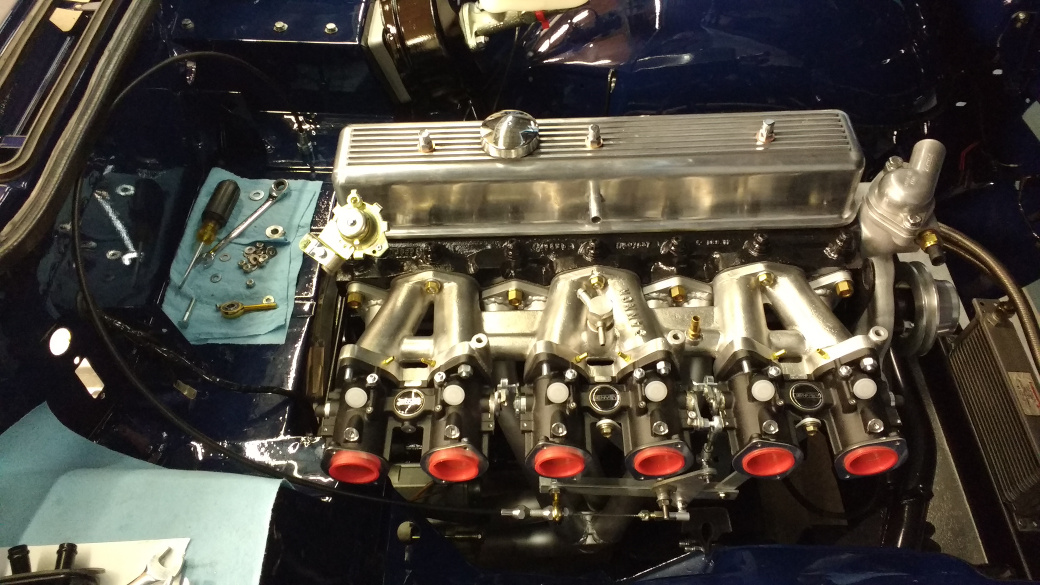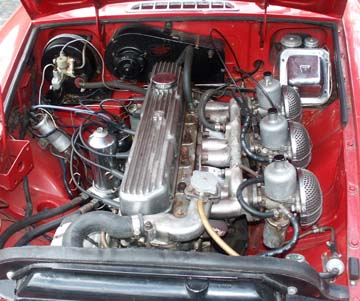
JoeTR6
HalfDork
2/16/18 8:26 a.m.
For my TR6 project, I'm in the midst of forming a heat shield to go between the intake and exhaust header. The exhaust is ceramic coated all the way through the firewall. I'm using a Cannon Weber intake that is fairly tightly placed between the exhaust header tubes near the head, so it will be difficult forming a heat shield between the two. I'm considering just putting a heat shield under the throttles, if anything to protect the throttle cable/linkage that is under them. But I'm getting bogged down and need to keep things progressing. Here's what I'm dealing with.

So what do you guys think? Worth doing or overkill?
Id run it as it, if you run into issue down the line you can always make one later.
I'd want to put something there since it's a non-crossflow engine. Maybe header wrap? Use volcanic to avoid becoming a pincushion for fiberglass sheddings. There's also formable heat shielding available from companies like HEI, similar to the stuff you see from the factory on modern cars. That might fit in more easily than a sheet metal piece.
You may be ok with the ceramic coating, as it should cut down on the heat a bit. I'd also look to these (GRM / CMS) supporters, as they all make products you may be able to use:
Design Engineering
Thermo-Tec
Koolmat
Also--- for header and exhaust coatings we've used Swain Tech, with great results:
Swain Tech

Ian F
MegaDork
2/16/18 9:50 a.m.
I would say it's probably a good idea to try to keep heat away from the injectors so the fuel in them doesn't boil. After that I don't think it will matter as much. As warmer air keeps vapor in suspension better, a bit of heat after the injectors might actually be a good thing, similar to how carburetted engines often pull compartment air because the warmer air can vaporize fuel better than cool air (all something I've read recently, although it makes sense in a way).
You could also funnel air from the front of the car to the area between the intake and exhaust to help cool it down while moving.
Having an exit for the hot air helps as well.
I would put a shield of some sort in there and a cold air box for the throttle bodies.
The ceramic coating will help a lot and a header wrap won’t help all that much over a heat shield with some insulation on it.
I race a Datsun in lemons which has a non cross flow head I6 with EFI. When we would come in for a pitstop to refuel the intake and fuel line would heat soak and boil the gas in the line. Restarting was tough and it would run like crap till we made it to the end of the pits. Twice the car didn’t want to restart at all and we had to be towed back to the garage till it cooled down. After 2 seasons of racing we realized there should have been an OEM heat shield bolted to the underside of the intake. Once we installed that our heat soak problems went away.
So yeah, I'd say its worth it to run a heat shield.
I think its far less important than it would be with carbs. Insulate the fuel lines, route them away from the heat as soon as you can, and make sure you have a residual pressure valve somewhere. Fuel under pressure is way less prone to bubbles with the engine shut off.
Like the above post says, the bugle fuel line on Datsun 280 ZX cars had a problem with it, and that was still fuel injected at that time

JoeTR6
HalfDork
2/16/18 9:47 p.m.
Thanks everyone. My planned fuel line routing has the supply line running up the driver's side of the engine block, around the front, and into the fuel rail. After the fuel rail, there will be a short flex hose to a regulator on the firewall, then straight down to the return line. That's as short of a route as possible, and will keep the supply as far away from the header as feasible.
I think I'll put a smaller heat shield under part of the intake and extend it down the throttle linkage using standoffs. This should keep direct heat off of the throttles and fuel rail/injectors. As for the air supply, I'm thinking of using a 3.5" aluminum tube to connect the intake runners. The air filter housing I have sits in front of the radiator shroud and is 3.5" in diameter. It has a flex hose that will run back to the aluminum plenum. From there, I'll have a 40mm tube and flange for each runner that fish mouths into the 3.5" tube. Not planning on air horns at the moment. This is sort of like the stock petrol injection setup on the TR5. Cold intake air and a straight, consistent diameter run.

Gus
New Reader
2/16/18 10:54 p.m.
Make an airbox and cover it with insulation from the outside. I have a non-crossflow ford 200 and this is what I did with mine: NACA duct and a cake pan. 

It really depends on how much heat comes off and what is close to it.
When I built my triple carb set up for my MGC, I decided to try without sheilding and never had any problems. Agree it is a PITA to create effective sheilds in situations like this. The tubular header is right below the intake as on your car.


JoeTR6
HalfDork
2/17/18 9:51 p.m.
In reply to pilotbraden :
That is nice. I like me some classic Mustang. Putting a NACA duct on the hood would be great, but the hood's already painted and I'm using side draft throttles.
I don't know the answer but you have a sweet looking engine there.
Almost every car from the last decade should have sheets of double layer/honeycomb type sheet between the exhaust and the body underneath. The stuff on the bottom of my Mercedes was in particularly large sheets. It's easy to cut and form though in OE applications it seems to mostly be used downstream of the cats, so there might be something I'm not thinking about. A junkyard trip or even a stealthy trip to a neighbor's house should yield more than enough to test.
Id say try to pipe in outside air and make sure it can get out. Might be most effective overall

JoeTR6
HalfDork
2/18/18 8:59 a.m.
In reply to mazdeuce - Seth :
Thanks for this. You reminded me of another issue. I left a straight length of exhaust pipe after the wide band sensor and before the rear gearbox mount in order to add a spun cat (eventually). I will definitely need some of that material. Even the stock exhaust makes the tunnel and passenger floorboard quite toasty.

JoeTR6
HalfDork
2/18/18 9:09 a.m.
malibuguy said:
Id say try to pipe in outside air and make sure it can get out. Might be most effective overall
I was thinking about this from an earlier comment. I could add a second duct from the radiator shroud and run it to the space in between the intake and exhaust. Heat shielding takes care of the radiated heat, but will heat soak and continue to heat the air surrounding it. A fresh air supply helps moves that out. Venting isn't an issue as a TR6 is completely open underneath. It will vent under the car. Unfortunately, it's too late to add side vents like the Triumph Works rally TR4s.
https://bringatrailer.com/2017/02/01/lhd-works-rally-replica-1963-triumph-tr4-w-fia-passport/

JoeTR6
HalfDork
2/18/18 9:15 a.m.
And BTW, thanks to Carl Heideman and GRM for making me even consider this improvement.











































